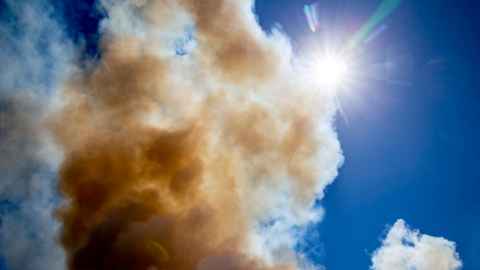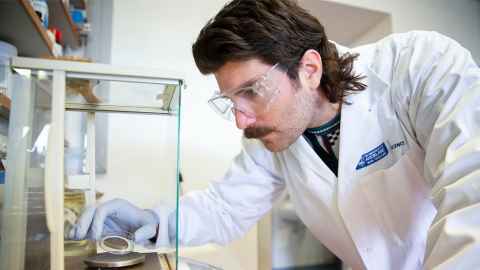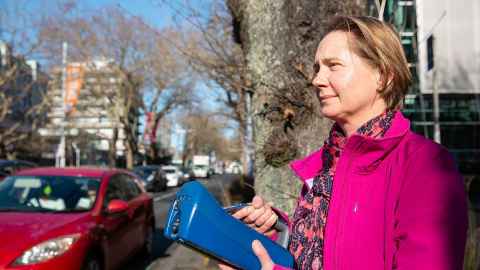Waving goodbye to wood smoke and car fumes
29 October 2021
Our researchers investigate what’s really in the air we breathe and how we can make it cleaner and fresher in our urban areas.

The wood burner crackles away merrily, spreading warmth throughout your home. Its smoke goes up the chimney and out of sight. But you may be breathing in this smoke after all. It can escape from your burner and into your living room. It can hang around urban areas as a low-lying haze, especially in winter. It may infiltrate your indoor air through open doors, windows and even ventilation systems.
Domestic wood burners are one of the main contributors to poor air quality in Aotearoa New Zealand, along with vehicle emissions. Smoke is made of particulate matter, explains Dr Joel Rindelaub from the School of Chemical Sciences. “These tiny particles hanging out in the air are terrible for you as they have a lot of carcinogens and cancer-causing compounds.
“There’s a lot of this really high-risk particulate matter specifically with these combustion processes – they seem to form the smallest type of particles and the smaller they are the more dangerous they are.”
Invisible pollutants
The smaller the particle the more dangerous it is to human health as it can travel further within our bodies. Particles less than 2.5 microns can get deep into the lungs, while nanoparticles which are smaller still can pass through the lungs and into the heart, ultimately reaching the brain, says Joel, who’s focus lies in atmospheric chemistry.
“Those happen to be three of the most important organs in your whole entire body. So once these particles get into your body, they can be transported anywhere.”
Although New Zealand’s air quality is relatively good by global standards, the country currently only regulates particulate matter 10 microns or less in size (PM10). But the Government is working on proposed amendments to the National Environmental Standards for Air Quality (NESAQ) which will target PM2.5, the smaller particles that can impact our health, and which is regulated in most developed nations already.
Wood and coal combustion is one of the main sources of PM2.5 in New Zealand and so included in the proposed changes is a lowering of the emissions standard for all domestic solid-fuel burners to reduce PM2.5 in our air, particularly during the colder months.

Joel says it’s an analytical challenge to understand the complexity of particles that are smaller than 10 times the width of your hair. His research looks at understanding some of the sources of air pollution that are occurring in New Zealand, that might not be on our minds, not only from outdoor activities such as fireworks but the quality of air in our homes, cars, and workplaces.
“People will be happily sitting around a bonfire for hours in the middle of the beach and not realise what is in the air they are breathing and that the reason their hair smells like smoke for the next week is because of toxic particles.”
To find out what particles are in the air, he traps them using a filter system. “Much like a coffee filter will collect ground up coffee beans, our filter will collect tiny little particles suspended in the air. Once the particles have been collected, we can analyse them in the laboratory using mass spectrometry to understand their chemical compositions,” he explains, often partnering with Auckland Council to measure the air quality at sites throughout Auckland.
“Previously, we have measured the air quality in West Auckland during Guy Fawkes celebrations and on Custom Street in the CBD leading up to the summer holidays. One surprising finding was the presence of illicit drugs (at low levels) in background urban air.”
Humans have done a great job of polluting the environment with our own synthetic creations.
Airborne microplastics
Joel is also co-supervising masters student Wendy Fan from the School of Environment, who is investigating whether microplastics are in the air. A grant from Maurice and Phyllis Paykel Trust enables Joel to study some of the inhalable microplastics and he helped Wendy with the chemical analysis of her rainwater samples.
“Everything that’s in clouds or that becomes rain has been transported there from the atmosphere at some point,’ says Joel. “And what we want to do is understand where it came from and why it’s there.” They measured for the presence of microplastics using fluorescence microscopy and found microplastics present in the rainwater.
“So when it’s raining on you, it’s literally raining plastics,” says Joel. “Humans have done a great job of polluting the environment with our own synthetic creations.”
Using a cutting-edge technique called pyrolysis GCMS, they can identify the type and the exact amount of each plastic in the samples and are aiming for their paper to be published by the end of this year.

Reducing your exposure
Professor Jennifer Salmond from Environment is also one of Wendy’s co-supervisors alongside Associate Professor Kim Dirks from Engineering, whom Jennifer has collaborated with to explore the pollutants people are exposed to as they move around a city.
Jennifer has always been intrigued by the link between human activities and the quality of the air we breathe and uses this knowledge to create mitigation strategies for urban pollution. She is interested in thinking about how we can use low-cost instruments to measure exposure levels and effectively identify transient pollution hotspots in cities, not only to help individuals protect their own health but to inform the development of policy tools that can make a difference to population health.
“The low-cost instrument research has been a project for many years (funded by MBIE) and is ongoing as we enhance our techniques for auto-calibration using modelling and statistical approaches, as well as improving the instruments themselves,” says Jennifer.
“For example, we are currently working with Mote Ltd to develop low-cost particle sensors which overcome some of the current limitations of commercial sensors for measuring specific particulates (such as very small black carbon particles and asbestos-like fibres).”
An example where people have already benefited from mitigation strategies reducing pollution exposure is the introduction of a requirement for idling buses to turn off their engines at bus stops, says Jennifer. But even better, Auckland’s red bus fleet became fully electric earlier this year, these are quieter and cleaner than the diesel buses and a step closer to electrifying Auckland’s entire bus fleet which is likely to have a significant impact on air quality in the city centre.
She says there are low-cost aspects of urban planning that can make a difference to pollution exposure daily, such as separating pedestrian areas of a city from the vehicle areas. Pedestrians can also make small choices with a big impact, such as walking on the opposite side of the road from a queue of idling cars and distancing themselves from the exhaust fumes. Another is taking two steps back from an intersection crossing rather than waiting right on the curb. “Increasing your distance by even a meter or two can make a difference.”
Clean, healthy cities
Joel says reducing pollution in New Zealand on a large scale comes down to two main factors. The first is to improve the build and insulation quality of housing so less heating is needed to enjoy a warm home. But equally important is increasing the use of cleaner heating sources such as ultra-low emissions wood burners or heat pumps.
The second factor is having more electric cars on our roads, says Joel. “We need to improve our vehicle fleet, so we aren’t producing such high amounts of dangerous air pollution.”
Jennifer says she would like to see healthier, sustainable cities. “I’d like to see a city that’s a fun, clean, vibrant living environment. It’s not noisy, it’s not polluted. It’s a happy, clean, healthy, and safe place where people enjoy to stop and mingle as well as commute through. It is possible to design and to modify cities to create these types of urban environments and what they’re already doing down on Quay Street I think is really heading in the right direction.”
inSCight
This article appears in the 2021 edition of inSCight, the print magazine for Faculty of Science alumni. View more articles from inSCight.
Contact inSCight.